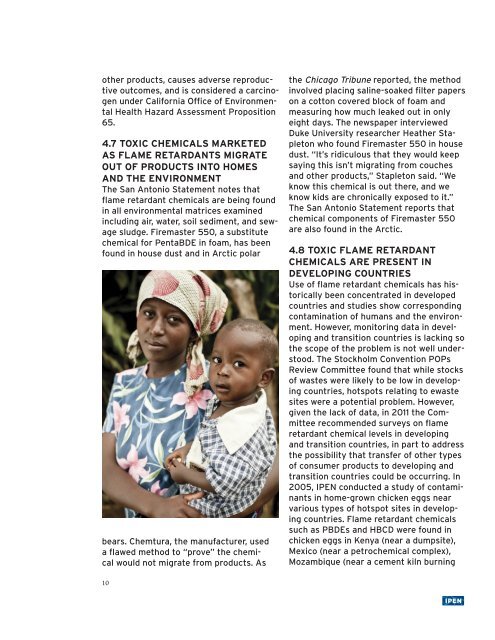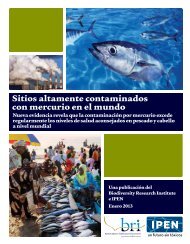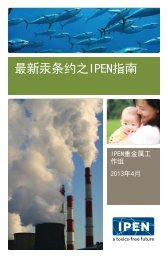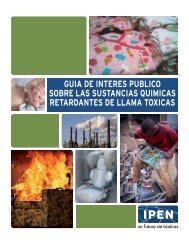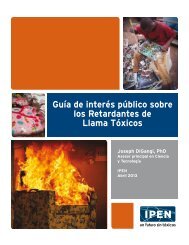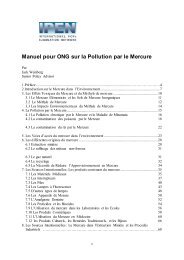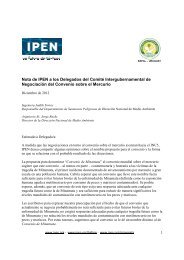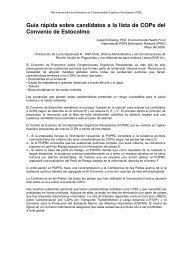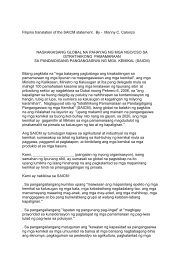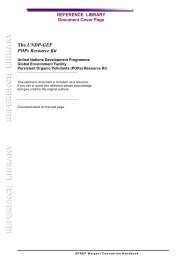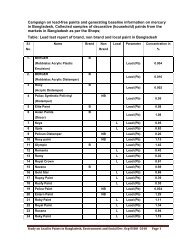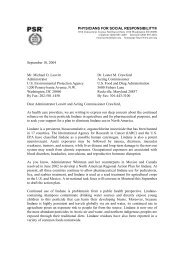A Public Interest Guide to Toxic Flame Retardant Chemicals
A Public Interest Guide to Toxic Flame Retardant Chemicals
A Public Interest Guide to Toxic Flame Retardant Chemicals
You also want an ePaper? Increase the reach of your titles
YUMPU automatically turns print PDFs into web optimized ePapers that Google loves.
other products, causes adverse reproductive<br />
outcomes, and is considered a carcinogen<br />
under California Office of Environmental<br />
Health Hazard Assessment Proposition<br />
65.<br />
4.7 TOXIC CHEMICALS MARKETED<br />
AS FLAME RETARDANTS MIGRATE<br />
OUT OF PRODUCTS INTO HOMES<br />
AND THE ENVIRONMENT<br />
The San An<strong>to</strong>nio Statement notes that<br />
flame retardant chemicals are being found<br />
in all environmental matrices examined<br />
including air, water, soil sediment, and sewage<br />
sludge. Firemaster 550, a substitute<br />
chemical for PentaBDE in foam, has been<br />
found in house dust and in Arctic polar<br />
bears. Chemtura, the manufacturer, used<br />
a flawed method <strong>to</strong> “prove” the chemical<br />
would not migrate from products. As<br />
the Chicago Tribune reported, the method<br />
involved placing saline-soaked filter papers<br />
on a cot<strong>to</strong>n covered block of foam and<br />
measuring how much leaked out in only<br />
eight days. The newspaper interviewed<br />
Duke University researcher Heather Staple<strong>to</strong>n<br />
who found Firemaster 550 in house<br />
dust. “It’s ridiculous that they would keep<br />
saying this isn’t migrating from couches<br />
and other products,” Staple<strong>to</strong>n said. “We<br />
know this chemical is out there, and we<br />
know kids are chronically exposed <strong>to</strong> it.”<br />
The San An<strong>to</strong>nio Statement reports that<br />
chemical components of Firemaster 550<br />
are also found in the Arctic.<br />
4.8 TOXIC FLAME RETARDANT<br />
CHEMICALS ARE PRESENT IN<br />
DEVELOPING COUNTRIES<br />
Use of flame retardant chemicals has his<strong>to</strong>rically<br />
been concentrated in developed<br />
countries and studies show corresponding<br />
contamination of humans and the environment.<br />
However, moni<strong>to</strong>ring data in developing<br />
and transition countries is lacking so<br />
the scope of the problem is not well unders<strong>to</strong>od.<br />
The S<strong>to</strong>ckholm Convention POPs<br />
Review Committee found that while s<strong>to</strong>cks<br />
of wastes were likely <strong>to</strong> be low in developing<br />
countries, hotspots relating <strong>to</strong> ewaste<br />
sites were a potential problem. However,<br />
given the lack of data, in 2011 the Committee<br />
recommended surveys on flame<br />
retardant chemical levels in developing<br />
and transition countries, in part <strong>to</strong> address<br />
the possibility that transfer of other types<br />
of consumer products <strong>to</strong> developing and<br />
transition countries could be occurring. In<br />
2005, IPEN conducted a study of contaminants<br />
in home-grown chicken eggs near<br />
various types of hotspot sites in developing<br />
countries. <strong>Flame</strong> retardant chemicals<br />
such as PBDEs and HBCD were found in<br />
chicken eggs in Kenya (near a dumpsite),<br />
Mexico (near a petrochemical complex),<br />
Mozambique (near a cement kiln burning<br />
10


